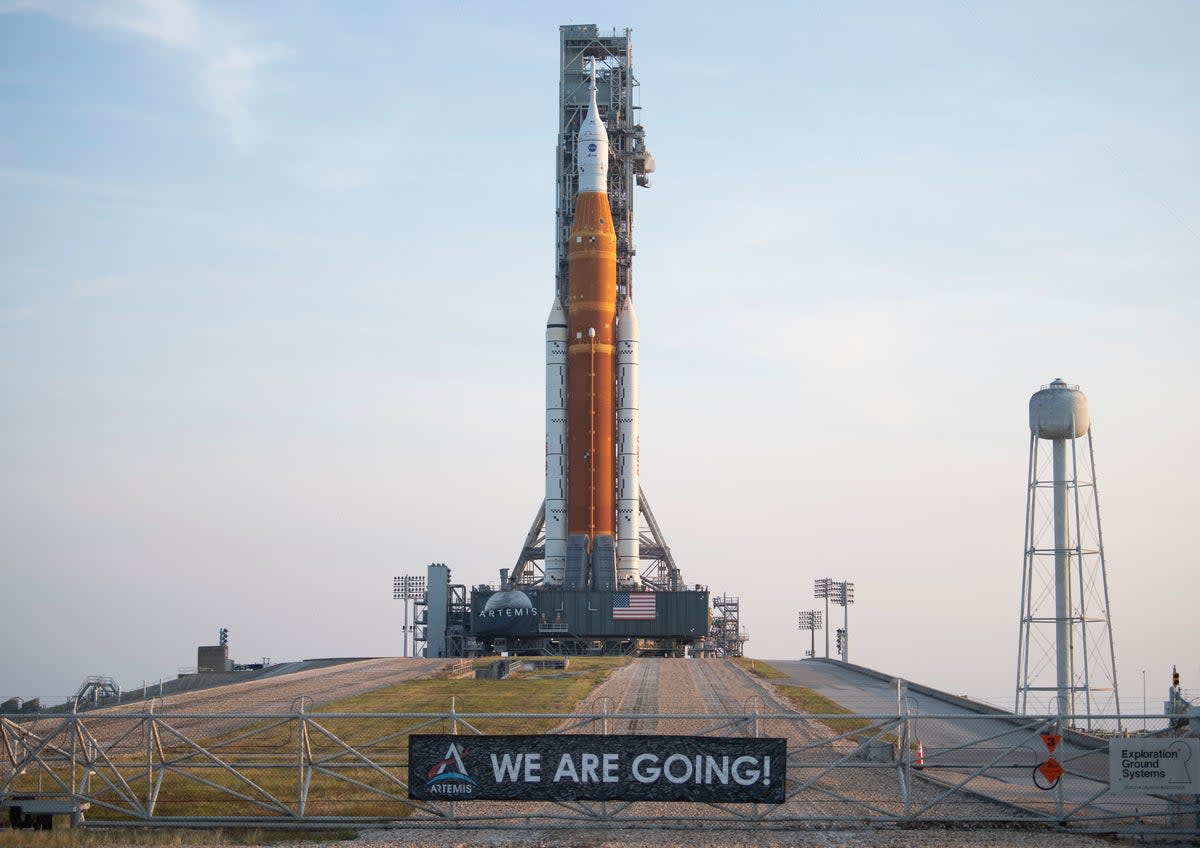How Nasa’s new Moon rocket compares to the Saturn V of the Apollo program

As soon as the morning of 29 August, the largest rocket to ever fly will lift off from Nasa’s launch complex 39B at Kennedy Space Center, in Florida.
The Artemis I mission, the first flight of Nasa’s new program to return humans to the Moon by 2025, will take to the skies courtesy of Nasa’s Space Launch System, or SLS, a massive heavy-lift rocket that looks a bit like a mashup of the Space Shuttle and the Saturn V rocket that took Apollo astronauts to the Moon more than a half-century ago.
SLS will be the most powerful rocket since the Saturn V, but will surpass the vaunted old rocket, even as it launches the new Orion spacecraft on a lunar flyby in a mission configuration reminiscent of Apollo, but with important upgrades and differences.
Here’s what you need to know about the differences, and similarities, of Nasa’s big Moon rockets of both today and yesteryear.
What are the Space Launch System and the Saturn V?
Both the Saturn V and SLS are, or were, in the case of the Saturn V, super heavy-lift launch vehicles designed to loft large payloads and human crews into orbit and set them on a course for the Moon.
The Saturn V, still the most powerful rocket to ever fly, pending the launch of SLS, was first flown in an uncrewed test flight in 1967, and launched its first crewed flight in 1968, the lunar flyby of Apollo 8. The Saturn V was produced to launch the Apollo spacecraft and, with later missions such as Apollo 11, the Lunar Excursion Vehicle that carried astronauts Neil Armstrong and Buzz Aldrin to the Moon’s surface in 1969.
The Saturn V was used for the entire Apollo program, culminating in the last mission to the Moon, Apollo 17 in 1972. The big rocket was also used to launch Nasa’s first space station, Skylab, in 1973, which turned out to be the last Saturn V launch.
SLS is the cornerstone of Nasa’s Artemis program, Nasa’s 21st-century program to return humans to the Moon, and is in many ways a contemporary update of the Saturn V using newer technologies and designed to power a more ambitious set of missions than seen in the Apollo program. SLS will launch the Orion spacecraft, itself a capsule-style vehicle superficially similar to the Apollo spacecraft, but packed with modern electronics and design features.
Artemis I is intended as a test flight of both the SLS rocket and the Orion spacecraft, that will see the latter circle the Moon as part of a 42-day mission to check out flight systems, and ensure the Orion spacecraft can safely reenter Earth’s atmosphere. If all goes well, a crewed lunar flyby, Artemis II, is scheduled for May of 2024, while Artemis III is scheduled for sometime in 2025.
It is Artemis III that will see the first humans land on the Moon since 1972.
How do SLS and Saturn V compare physically?
The Saturn V was a massive, powerful rocket, standing 363 feet tall and weighing about 6.5 million pounds at the launch pad. The Saturn V generated around 7.6 million pounds of thrust at take off and consisted of three stages.
The SLS as currently configured is a little shorter than the Saturn V, coming in at 322 feet, and lighter as well, weighing about 5.5 million pounds. But SLS “block 1,” as the present configuration of the rocket is called, can generate 8.8 million pounds of thrust at lift off. Later versions of SLS with more powerful upper stages will produce even more thrust.
The SLS is a two stage rocket, but unlike the Saturn V, and like the Space Shuttle, uses two solid rocket boosters attached to the side of the big rocket’s main booster stage.
Unlike newer commercial rockets such as the SpaceX Falcon 9, neither SLS nor Saturn V were reusable.
How do SLS and Saturn V compare on cost?
The Saturn V cost about $1.5 billion in today’s dollars per launch, while the entire Saturn V development program cost around $51.8 billion.
The SLS will cost an estimated $4.1 billion per launch, but the cost of developing and building the SLS so far is around $23 billion.

